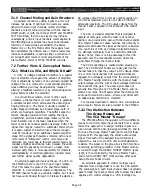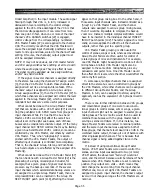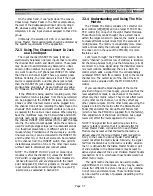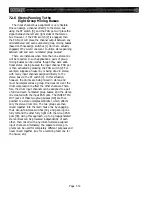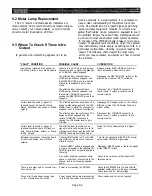
maintain an ideal S/N ratio while avoiding tape satura-
tion. At the same time, the mix matrix can create
working mixes of those groups, with levels adjusted for
more “listenable” reference monitoring or foldback.
Alternately, some of the aux mix busses can be used for
performer cue mixes or foldback, while others can be
used for effects sends or to supplement the group mixes
when even more tracks must be recorded (eight group
outs plus eight aux outs = 16 tracks). If the matrix is
used for monitor or foldback mixes, its matrix sub
inputs can be used for echo return so that monitoring
can be “wet” while recording mixes are “dry.” Direct Out
jacks on the input channels also make it possible to feed
a multitrack recorder of up to 48 inputs with the
cleanest possible, direct-fed signals.
Built-in talkback capability is provided, and a dual
monitor system with automatic “control room” output
muting during talkback make it possible to monitor the
console outputs (via an external amp and loudspeakers)
without wearing headphones.
A mix matrix permits 11 sources (the eight groups,
the stereo bus, and individual matrix sub inputs) to be
mixed into eight different outputs. This 11x8 matrix, a
“mixer within a console,” makes it possible to control
groups of similar instruments (or vocals) with the
Group Master Fader, and to then remix those groups. In
film work, for example, the mixes might be: left, center,
right, surround... or stereo music, stereo dialogue, stereo
effects, plus a mono or stereo combined reference mix.
Overlaid on the L/C/R/S or M/D/E matrix mixes, the
VCAs can control all the channels applicable to different
scenes, thus providing “double-group” capability.
Control room outputs, in addition to a pair of head-
phone outputs, make monitoring more convenient. The
talkback output facilitates communication with the
studio and can be tied to intercom systems.
8.1.3 Post Production
Once a show has been photographed on video, film or
multi-image media, it's time for the crucial post production
job of mixing sound effects, music, and/or dialog. Sometimes
there is no “original” production soundtrack, and all
recording is done in the post production phase, while other
times the post production task is primarily one of enhance
ment. In any case, the PM4000 is well suited to the task. Its
many inputs can be switched to handle virtually any input
level, from the lowest level mics to very “hot” electric
guitars, electric keyboards, and virtually any tape recorder
or film chain. Cue switches on just about every input and
bus make it possible to check signals “in place” without
disrupting the output mixes. Sounds can be precisely
tailored, and defects “surgically removed” using the four-
band parametric equalizers on each input channel, as well
as the sweep frequency high pass filters that go as high as
400 Hz. Insert in/out jacks on every bus and input channel
make it possible to patch in whatever signal processing is
desired. Insert On switches on the input channels let you
switch the signal processor in or out of the circuit with the
touch of a finger. Similar convenience is provided by the
eight Master Mute groups, which switch assigned input
channels on and off instantly, and by the eight VCA Master
Groups that additively alter the set signal level on any
channels which have been switch-assigned to a particular
VCA group. A secondary use for the Insert In connections is
to accommodate the +4 dBu signals from a multitrack tape
machine; these channels’ Insert switches can be used to
select either the tape return or the normal channel input,
making it possible to switch from live to taped sources
without patching.
8.1.4 Video
Video production today uses more live music, more
pre-recorded sources, and more special effects than
ever. Music videos, stereo VCRs and stereo TV broad-
cast have elevated the importance of video sound
quality. With its high quality sound and powerful
capabilities, the PM4000 is a logical choice for many
video sound production requirements. Its 24, 32, 40 or
48 input positions, which accommodate even more input
sources when loaded with stereo input modules, can
handle the substantial numbers of mics, instruments
and pre-recorded sources for almost any production.
Sub inputs allow two consoles to be linked together for
occasions when even more inputs are needed.
The PM4000 has eight group busses, so different
groups of instruments or mics can be assigned to their
own group and controlled with a single fader. The stereo
bus can be used for an independent, direct-assigned mix
of the inputs, or it can be fed from the Group Master
Faders, acting as a “grand master” for the console. The
PM4000 also has eight mono auxiliary mixing busses
and two stereo aux busses (or 12 mono aux busses,
depending on how you set the front panel switches) that
can be used for effects sends, for headphone cue mixes,
or as additional group busses. Additionally, there are
eight VCA groups which can be used instead of or to
augment the group masters. This adds up to some 30
output mixes... and there’s also a Mix Matrix. The Mix
Matrix can create live mixes of the various groups so
performers can hear what’s happening during the
production, while other console outputs simultaneously
provide different mixes for recording. A separate control
room output can be used to feed local monitor speakers,
and an input priority cue system lets the operator
instantly check any input channel or auxiliary return at
the touch of a single switch.
Page 8-2
Summary of Contents for PM4000
Page 1: ...PROFESSIONAL AUDIO MIXING CONSOLE PM4000 OPERATING MANUAL YAMAHA ...
Page 2: ...PM4000 OPERATING MANUAL ...
Page 7: ...Section 1 Introduction ...
Page 11: ...Section 2 Brief Operating Instruction ...
Page 47: ...Section 3 Specifications ...
Page 51: ...Dimensional Drawings PM4000 Console all versions Page 3 4 ...
Page 52: ...Page 3 5 ...
Page 53: ...Page 3 6 PM4000 Console Rear Profiles ...
Page 54: ...Module Block Diagrams See back of the manual for overall system block diagram Page 3 7 ...
Page 55: ...Page 3 8 ...
Page 56: ...Page 3 9 ...
Page 57: ...Page 3 10 ...
Page 58: ...Page 3 11 ...
Page 59: ...Page 3 12 ...
Page 60: ...Section 4 Installation Notes ...
Page 72: ...Figure 4 13 Cables For Use With Balanced Sources Page 4 12 ...
Page 79: ...SECTION 5 Gain Structure and Levels ...
Page 82: ...Figure 5 1 Dynamic Range and Headroom in Sound Systems Page 5 3 ...
Page 86: ...Section 6 Optional Functions ...
Page 106: ...Section 7 Operating Notes and Hints ...
Page 119: ...Section 8 Applications ...
Page 127: ...Section 9 Maintenance ...
Page 131: ......
Page 132: ...YAMAHA VN02300 ...




